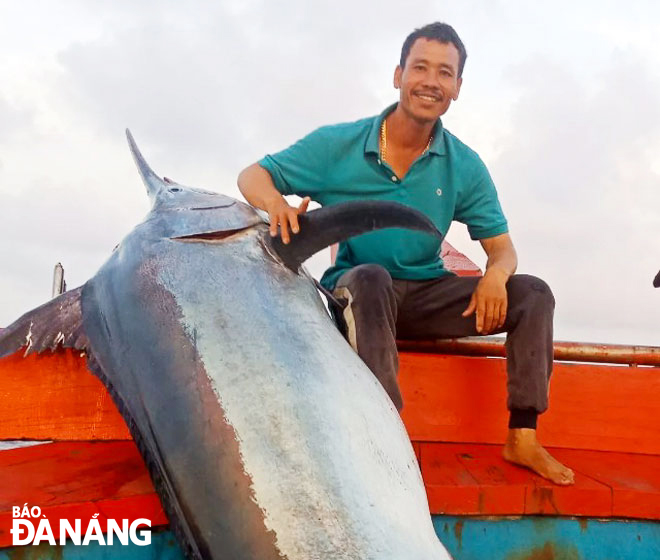Da Nang fisherman uses ice slurry technology for cooling his catch
With a strong desire to improve the quality of fish caught within Vietnamese waters and increase their value, fisherman Le Van Thien, a resident from Thuan Phuoc Ward, Hai Chau District, Da Nang, is using ice slurry technology to preserve his catch on his fishing boat.
 |
| Fisherman Le Van Thien and 200kg sailfish caught in the Hoang Sa waters. Photo: TRAN THANG |
Using modern technology to optimize the catch value
With decades of experience, fisherman Le Van Thien pointed out the fact that the number of Da Nang’s boats harvesting seafood has increased significantly in recent years, but preservation of fish by ice practised on board the vessel now becomes obsolete or outdated. Deep sea fishing boats usually return to harbour after spending months at sea, and the quality and value of their catch has dropped sharply due to using obsolete method for fish preservation.
In October 2019, the Japan International Cooperation Agency (JICA) selected fisherman Le Van Thien to donate more than 1 billion VND Ice-Maker from sea water, and transfer Japan’s fish preservation technique to him.
The expensive salt water ice maker is carefully wrapped and is located on the stern of Thien’s boat to protect it from the effects of climate change. It is only opened for use when needed. In order to keep the quality of the fish to remain unchanged for a long time, the fish should be cooled to the freezing point when it is arrested at sea. When freshly caught fish are properly cooled, there is an additional benefit in lengthening the duration of the fishing trip, allowing the catch to be maximized. Therefore, the use of the Japan’s fish preservation technique helps Mr Thien to enhance the quality of the catch and ensure the freshness of the products.
Salt water ice maker is designed to produce slurry ice on board fishing vessels. Slurry ice machine produces slush from seawater and it is used to cool down the catch after it has been gutted. The slush is pumped evenly into chilled tanks as they are loaded, whether it is with fish or other sea catch.
Mr Thien said that Japanese experts introduced the way how quickly freeze fish at sea after catching in order to be ensure that the fish is get on salt water ice as soon as possible after catching it. This will help keep the flesh firm and tasting fresh. Chilled seawater ice is an effective and beneficial tool for fishing boats to utilize in order to keep their catch in the best attainable condition. In addition to reducing the time at sea to 10-12 days, new fish preservation technology helps Mr Thien increase catch sizes and ensure better-preserved, higher quality fish, ultimately commanding higher prices at the market at the retail and wholesale levels.
Use of new technology as a tool for promoting exports of fishery products
Fisherman Le Van Thien hopes that all Vietnamese fishing vessels will be able to use new preservation technology to maintain and prolong the catch freshness, helping fishermen to increase their income.
He said that the new technology for fish preservation is very expensive but it will bring long-term benefits to fishermen. He sugested that Vietnamese fishermen, including those from Da Nang, should apply this new technology for fish preservation in order to to optimize the value of their catch and not waste valuable fisheries resources within Vietnamese waters. This will help to ensure Vietnamese fishery products are eligible for export to Japan, South Korea, and the United States.
Reporting by TRAN THANG – translating by H.L








